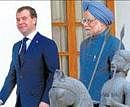

This will be only the third instance of a successful Indo-Russian collaboration of the kind in the military sphere after BrahMos supersonic cruise missile and the recent multi-role transport aircraft project.
But the scale of spending in the fifth-generation stealth fighter aircraft would far surpass any other in the history of Indian defence procurement/ development programme. India would be spending close to $ 36 billion (approximately 1.8 lakh crore) to develop and produce the GenNext fighter plane. The Indian Air Force (IAF) plans to induct between 250-300 of these fighters by 2030.
The fifth-generation fighters have better manoeuvreability, higher strike rate and improved networking. They also have stealth features making them difficult to detect by radar and the ability to super-cruise - cruising along in supersonic speed.
At the moment, only the US has a fifth-generation fighter, F-22 (Raptor) and trial is on with F-35. China too is developing its own fifth-generation version. If things go as planned, IAF may have its first FGFA by 2020.
A contract for the preliminary design of the FGFA was inked by Hindustan Aeronautics Limited (HAL) top brass with the representatives of Rosoboronexport and Sukhoi on the margins of the discussions between the Prime Minister Manmohan Singh and Russian President Dmitry Medvedev here on Tuesday.
“This is the biggest defence programme ever in the history of India involving production of over 250 aircraft,” a statement from HAL said. This is the first agreement in a series of contracts, to be signed later to cover different stages of the programme.
The Centre will initially release $ 295 million (close to Rs 150 crore) for completing the preliminary design of the air superiority fighter plane within the next 18 months, Defence Ministry sources said. Once the FGFA design is frozen, India will spend $ 5.5 billion (Rs 27,000 crore) to develop six prototypes. Subsequently, India is likely to spend $ 30 billion (Rs 1.5 lakh crore) to buy 300 aircraft at a cost of $ 100 million apiece.
Even though it would be based on the Sukhoi PAK- FA (T-50), the first prototype of which flew in January, 2010, there will be specific design changes suiting the Indian requirement. IAF, for instance, wants a twin-seater version and integration of an advanced engine with higher thrust at a later stage.
Once the design is frozen, a secure data-link would be established between New Delhi and Moscow for data exchange. Forty Indian scientists will be stationed at Moscow for developing the Indian prototype, scheduled to be ready by 2017.
The plan is to manufacture 6 prototypes and fly them for 2500 hours to get the airworthiness certificates. The first FGFA would be delivered to the IAF by 2020 and the fleet comprising 250-300 aircraft should be in place by 2030.
Two of India’s biggest defence procurement programmes before this –the Rs 42,000 crore deal to acquire 126 medium multi-role combat aircraft and the Rs 50,000 crore scheme to start the second production line of diesel-electric submarine with foreign partners - pale when compared to the Russian FGFA deal, which was in the works in the last decade.
